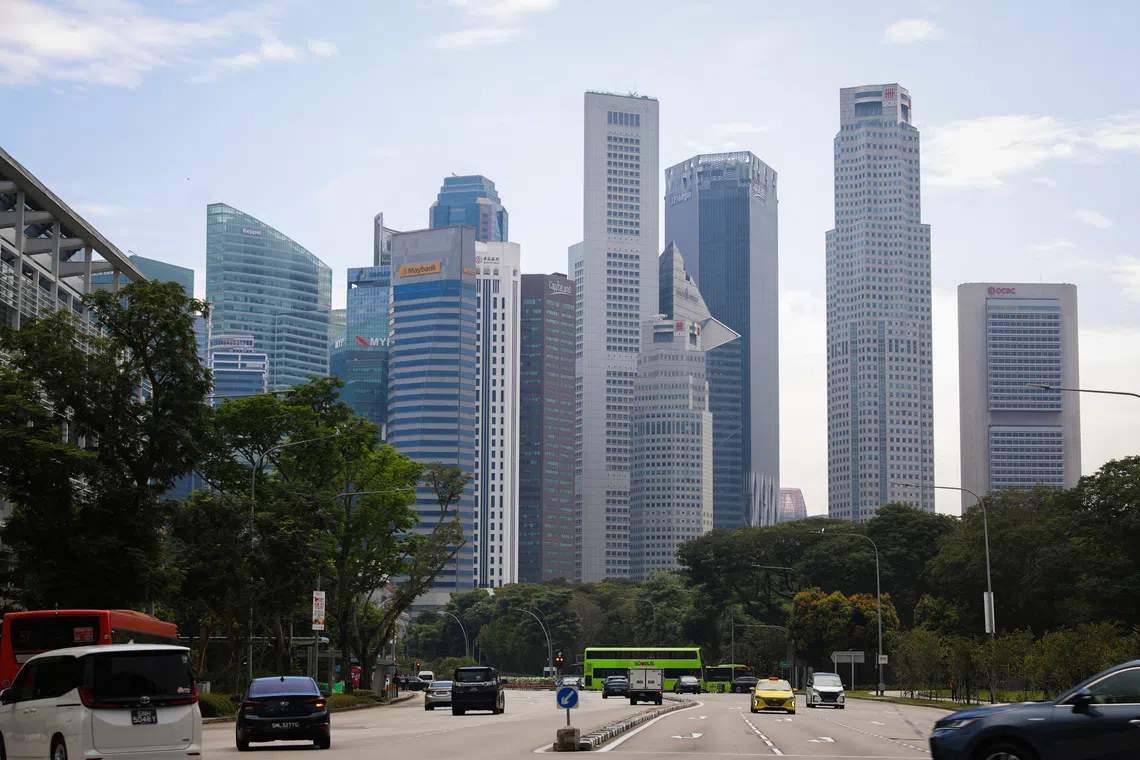Singapore economy beats forecasts with 2.9% growth in third quarter despite US tariffs
Sign up now: Get ST's newsletters delivered to your inbox

The resilient performance has prompted some economists to raise their full-year growth forecasts.
ST PHOTO: TARYN NG
Follow topic:
- Singapore's Q3 economy grew 2.9%, surpassing economists' 2% forecast, driven by manufacturing and domestic consumer sectors.
- MAS reported 3.9% growth in the first three quarters of 2025 but expects GDP growth to moderate in upcoming quarters.
- Manufacturing growth was flat year on year but up 6.1% quarter on quarter. Construction grew 3.1%. Services producing industries grew 3.5%.
AI generated
SINGAPORE – A construction boom, generous fiscal support and falling interest rates are cushioning the Singapore economy from the US tariff shock and an export slump.
This has prompted some economists to raise their full-year growth forecast.
Singapore’s economy grew 2.9 per cent in the third quarter of 2025 compared with the same period in 2024, advance estimates from the Ministry of Trade and Industry (MTI) on Oct 14 showed.
The third-quarter growth estimate was better than expected, beating economists’ forecast of 2 per cent growth in a Bloomberg poll.
Japanese bank Mitsubishi UFJ Financial Group said that while the growth marks a slowdown from the 4.5 per cent expansion recorded in the second quarter, this was due to high base effects from a year ago, and reflects a resilient pace of expansion amid global trade headwinds.
Manufacturing output avoided a contraction, and services are holding up, helped by robust tourism and supportive financial conditions, noted Nomura’s chief Asean economist Euben Paracuelles.
Maybank economists, Dr Chua Hak Bin and Mr Brian Lee, reckoned the export downturn would be short-lived.
“US inventories reflect limited front-loading; a boom in capital spending on artificial intelligence (AI) supports growth in electronics exports; and a significant proportion of exports, including electronics, is exempt from tariffs,” they said.
Front-loading refers to the rush by companies to increase imports, exports, and production before the US tariffs kicked in to avoid paying them. This can result in a short-term boost in trade.
Maybank is upgrading its 2025 growth forecast to 3.5 per cent, from 3.2 per cent previously, in view of the upside surprise in the third-quarter figures.
The economists said this implies that growth will come in at a slightly slower 2.5 per cent in the fourth quarter.
Maybank’s gross domestic product (GDP) forecast for 2025 remains well above MTI’s range of 1.5 per cent to 2.5 per cent, which the economists think will likely be upgraded in November.
Goldman Sachs, too, raised its 2025 full-year GDP growth forecast to 3.6 per cent from 3 per cent previously.
RHB has also revised its forecast to 3 per cent from 2 per cent to reflect the stronger-than-expected growth in the third quarter, even though it expects the growth momentum to moderate in the fourth quarter.
Ms Sheana Yue, senior economist at Oxford Economics, said US tariffs have been impacting trade flows through the Republic since April, and Singapore has so far benefited from the front-loading activity by US businesses.
However, the front-loading boost is set to fade now that tariffs have been hiked, she warned.
“Admittedly, implementation lags in the US could cushion the hit to Singapore’s exports in the near term. But a harsher payback effect is possible further down the line when US businesses draw down on their stockpile of orders instead of sustaining imports,” Ms Yue said.
Uncertainty looms over the US threat of higher tariffs on currently exempted semiconductors and pharmaceuticals. Pharmaceutical products make up roughly a third of all exports from Singapore to the US, she noted.
“The current ambiguity on pharmaceutical tariffs means future revenue streams from business investments are less certain. The uncertainty may delay investment, hiring and other major spending decisions. Moreover, in Singapore’s case, exports heavily influence investment decisions,” Ms Yue said.
This suggests that Singapore’s domestic demand will weaken again before long.
With Singapore clearly not out of the woods as external uncertainty remains high, Mr Paracuelles was not surprised that the Monetary Authority of Singapore (MAS) continued to flag downside risks and remains vigilant.
In a separate release on Oct 14, MAS said the economy grew 3.9 per cent in the first three quarters of 2025, faster than the same period last year.
It said growth is expected to moderate in the upcoming quarters as activity normalises in the trade-related sectors.
The central bank said in its macroeconomic review that barring a sudden increase in tariffs or a sharp fall in demand, companies in the manufacturing sector “should have adequate buffers to absorb price declines without significantly reducing production at least for the rest of this year”.
Global tech firms’ heavy investments in AI infrastructure should also support trade-related sectors here.
Higher demand for products that support AI applications, such as memory chips and servers, will also benefit Singapore, it added.
For 2026, the financial sector is expected to grow at a moderate pace, while the retail and food and beverage (F&B) services sectors are likely to register tepid, uneven growth.
“While retail spending has picked up recently, the boost from SG60 vouchers is expected to taper off as the vouchers approach their expiration date. Nevertheless, strong household balance sheets should provide a base layer of support,” said MAS.
The central bank said updated official growth forecasts for 2025 and 2026 will be unveiled by MTI in November.
In the third quarter of 2025, the year-on-year growth of Singapore’s manufacturing sector was flat, slowing from the 5 per cent expansion in the previous quarter, according to MTI data.
Growth was weighed down by lower output in the biomedical manufacturing and general manufacturing clusters, even as the output of other manufacturing clusters expanded.
But on a quarter-on-quarter seasonally adjusted basis, the manufacturing sector grew 6.1 per cent, a turnaround from the 0.7 per cent contraction in the second quarter.
The construction sector grew 3.1 per cent year on year, moderating from the 6.2 per cent growth in the preceding quarter.

PHOTO: MTI
Growth came from an increase in both public and private sector construction projects.
Among the services sectors, the wholesale and retail trade, as well as transportation and storage sectors, collectively expanded 2.5 per cent year on year, easing from the 4.9 per cent growth in the previous quarter.
The information and communications, finance and insurance, and professional services sectors grew 4.4 per cent year on year, extending the 4.3 per cent growth in the previous quarter.
Accommodation and food services, real estate, administrative and support services and other services sectors expanded 4.1 per cent, following the 4 per cent expansion in the preceding quarter.
All sectors within the group, except for the F&B services sector, grew during the quarter.


